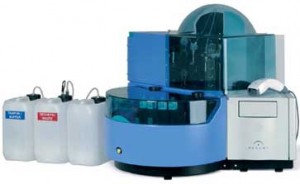One of the big risks for a patient undergoing abdominal surgery has been the threat of peritonitis, which means infection in the abdominal cavity. Apart from pneumonia, which can be another one of those life threatening diseases, peritonitis remains a severe threat even today, as it is accounting for roughly 60% of mortality in the surgical intensive care units. It is not the peritonitis itself that is the killer but the spread of the infection through the blood stream to vital organs. Once the vitals are affected, infection will lead to a general shutdown: multiple organ failure or septic multi-organ dysfunction syndrome known as MODS, which is what kills the patient.
Our ancestors could not control sepsis. Antibiotics had yet to be discovered. Today the main challenge remains a timely detection of sepsis. Once sepsis has overrun the body, even antibiotic treatment comes too late for the patient.
The best methods that are currently available for the detection of sepsis are CAT scans and fine needle aspiration. Both have their shortfalls: the CAT scan may be unavailable and fine needle aspiration can increase the infection risk. One biomarker, the C reactive protein has only a limited use to predict septic MODS, as C reactive protein levels show a sharp increase in the presence of surgical trauma, regardless whether there is infection or not. German research has tested another potential blood sepsis marker, procalcitonin. Unlike the C reactive protein procalcitonin levels are not affected by surgical trauma, but it shows an increase in the presence of bacterial or fungal infection. There is a rapid automated assay for procalcitonin, the Kryptor PCT essay. It can be completed in 20 minutes, which is important, as time is of essence in emergency situations. Among 82 recruited patients with peritonitis, more than half had infections due to E.coli. Nine had fungal infections. Procalcitonin levels were markedly higher in patients who later went on to suffer MODS. All patients in the study were tested within 96 hours of the onset of symptoms. C reactive protein levels were not useful in terms of a predictive value.
The test is useful for two purposes: it helps with the early detection of a septic condition, so treatment can start early. It also identifies patients who won’t develop septic MODS.The sensitivity and the accuracy of the test does not necessarily make it a true “sepsis marker”. Researchers believe that the degree of systemic procalcitonin reflects a weak immune system. The test picks up those patients who are susceptible to severe infections. As a result timely treatments can be started for them right away.
Reference: National Review Of Medicine, March 15,2007, page 3
Last edited December 5, 2012






